
This page written & compiled by Tammy Swan, please do not copy in any way without written permission & credit.

![]()
This page written & compiled
by Tammy Swan, please do not copy in any way without written permission &
credit.
All links on this page will conveniently open in a new window for you.
We at Ahmischi care
deeply where our kitties go, so we would like to make a few statements about
what we expect,
along with a few tips on grooming, etc & a little about the Persian breed:
We do not allow our
cats/kittens to be declawed, this procedure is very painful and can have very undesirable
after-effects.
Did you know that when they declaw, they do not just remove the nail, they
remove the first knuckle?! Some cats, after
they have been declawed, have temperament & behavioral issues/changes, as well
as litter box issues.
All pets will be spayed/neutered prior to placement, or will come with a
spay/neuter contract.
All cats/kittens placed require a signed contract to ensure their safety.
~***~
Please do not
contact us for a 'pet' quality cat, wanting to have 'just one litter.' There is
much to learn about breeding/showing
Persians, and you must be prepared for the
heartache that may follow, and the costs as well.
This is not a hobby you make
money at, by no means. Lots of research is a must.
We are breeders because we love the Persian breed, and we do all that we can to
improve & preserve the breed.
Here is an
excellent article that explains why
we place our kittens when they are at least 14-16 weeks old:
By Barbara C.
French
http://www.breedlist.com/faq/young.html
~***~
Personality & Grooming
We are very honest
about our cats, so we expect our buyers to be honest with us as well.
~***~
We do not allow our cats
to roam freely outdoors - they are strictly indoor cats. There are too many
dangers lurking
outside that can be very harmful, such as wild animals, cars/traffic, diseases,
and so on. Indoor cats live longer, more healthy
lives than outdoor cats for these reasons, and thus less trips to the vet for
any 'accidents' from outside.
~***~
Persians are very
gentle, people loving cats. Personality can differ from cat to cat, but they are
usually very loving, docile,
easy-going, somewhat active, playful lap-warmers.
They tend to be a little lazy, but are also active & outgoing!
They
are very laid-back and have wonderful temperaments.
~***~
It is important to keep Persians groomed. Their coats are usually thick and
cottony, or long and silky, but some tend to
have shorter, plush coats. We
recommend combing their coat every day or every other day so they don't get
knots.
A comb like this metal one is great:

It's good to bathe your Persian for routine, maybe every
two weeks, once a month, or maybe every
other month - whatever works best for you. Bathing also helps reduce knotting of
the fur, and helps new coat to grow.
Some
Persians coats can tend to be a little greasy, so this will help determine
how often
you want
to bathe your cat.
Never bathe a cat with knots, as this will only make them
tighter. so make sure you give their
coat a thorough comb-through.
If they have a knot(s), be sure to not pull roughly on them. You can help pull
the knots apart by separating them with
your fingers. If they are tighter, you can use a small pair of round-ripped
scissors to cut them out.
Always be careful so you don't snip their skin!
If you decide to
shave your Persian, it's best to learn from watching someone do it first. You
want to be
careful so as not to spook kitty with the clippers - when you first turn them
on, turn them on away from the cat so they can get
used to the noise & also the vibrations. If clipping on the belly and around the
legs/armpits, you must take extra precautionary
measures, as the skin is very loose in those areas and can easily become snagged
in the clippers. If shaving is a must, I would
recommend having someone you know that is experienced with clippers do it/help,
or take them to a groomer.
Shaving doesn't
hurt the cat. Some people choose to have their cats shaved in the summer months
to help keep them cooler,
and they look really cute in a 'lion cut'! We shave some of our Persians,
particularly ones we are not showing. As an
interesting note, if you shave a Himalayan, often times their body will darken
to their point colors (so if you shave a
Seal Point, the body may go from creamy white to a light to dark brown). Also,
if you do decide to shave the tail, be sure
to leave a pom-pom on the end. Tail fur also takes a very long time to
grow back.
Be sure to clip your kitties nails prior to
bathing to prevent any scratches. You may want
to trim the kitties nails 2-3 days before, as they can sometimes be a little
sharp after they are freshly cut.
We recommend
you trim your cat's nails at least once a week or once every two weeks. Trimming
nails is not painful, it is
just
like cutting your own nails! Just be sure not to cut down to the quick, which is
the 'live' part. If you go too long without
cutting the nails, they can grow into the paw pads! Do make sure you also have a
couple of cat scratchers in your home so kitty can help clean his nails & has a
place to scratch rather than on your sofa.
Our kittens get their first bath when they are
about 6 weeks old. This helps them get used to being
bathed, and as they
are
bathed on a regular basis it makes their coats easier to maintain. Our show
kitties are bathed on a regular basis
so they look the best for the shows. Blow drying them is a must. You don't want them to get chilled and catch cold.
Another option is to take your kitty to a groomer for maintenance
baths/grooming.
A very nice dryer is one like below, an Oster dryer, and on the right, a Metro
dryer:
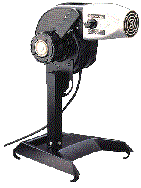

~***~
Health
Many people stereotype that Persians are not healthy cats, that they
always have URI's, & have difficulty breathing.
This is NOT so!
Reputable breeders only breed the healthiest cats, and this is how it is done
for generations - a stronger immune system
is built up and thus shows in the lineage.
Some Persians may have small nose nares, which is not the desired structure of
the nares, but they are still healthy. Some
Persians may 'snore' too. Most
Persians eyes also tear as well, some more than others. This is normal for the
breed and
is easily
cleaned by gently wiping with a warm, damp tissue.
~***~
The dishes that you have your cats eat & drink from is important. Stay away from any plastic bowls,
as this
can cause Acne on your cats chin or allergic reactions. You should only use
metal/stainless steel or ceramic/marble dishes.
~***~
PKD (Polycystic Kidney Disease) is an inheritable disease of the Persian breed.
Much research has been done on this over the
years. PKD can severely effect the
cat's health and may eventually cause death, but an affected cat will more than
likely pass
due to old age or something other than PKD. All of our breeding cats
were Ultrasound Scanned with a 10mHz machine
by Dr. Lane of Pennsylvania in
2000. She is well trained in this field.
In January of 2005, the U.C. Davis
Veterinary Genetics Laboratory came out with the much anticipated PKD DNA test.
This was a major breakthrough for the Persian breed!
In 2005 we slowly began testing cats by the PKD DNA test, and we continue to do
so.
All of the scans done by Dr. Lane matched the DNA results thus far, so we can
attest to her superb skills & accuracy.
~***~
Colors, Patterns, & Divisions
The Persian breed
comes in seven divisions. They are:
Solid
http://www.cfainc.org/breeds/profiles/persian-solid.html
Silver & Golden
http://www.cfainc.org/breeds/profiles/persian-silver.html
Shaded & Smoke
http://www.cfainc.org/breeds/profiles/persian-shaded.html
Tabby
http://www.cfainc.org/breeds/profiles/persian-tabby.html
Particolor
http://www.cfainc.org/breeds/profiles/persian-parti.html
Calico & Bicolor
http://www.cfainc.org/breeds/profiles/persian-bic.html
Himalayan
http://www.cfainc.org/breeds/profiles/persian-him.html
~***~
All Persians have
copper eyes (which vary in shades from dark to light), with the exception of;
Whites, which can have Copper, Blue, or Odd eyes (one color of each).
Himalayans only have Blue eyes.
Shaded/Chinchilla
Silvers & Goldens must have Green or Blue-Green eyes.
Tabbies & Bicolors in Silver, Silver Patched, Blue-Silver, & Blue-Silver Patched can have
either Green, Hazel, or Copper eyes.
And Bicolors commonly have Copper eyes, but also accepted is Blue or Odd eyed.
Our Odd-Eyed White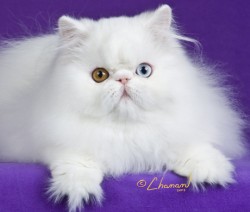 |
~***~
You can read the
Persian Breed Profile & Persian Standard here at the CFA website:
http://www.cfainc.org/breeds/profiles/persian.html
http://www.cfainc.org/breeds/standards/persian.html
~***~
We would like to make
note, that most people come to believe that the Himalayan is a different breed
of cat.
The Himalayan is a Persian. The Himalayan pattern was created by breeding
Siamese to Persians, and after years of
dedicated
work by the pioneers of the Himalayan, they have had their efforts fulfilled. The
Himalayan was first accepted
as a breed
in CFA in the year of 1957. Eventually in 1984, they were merged into the
Persian breed. Himalayans have the same
exact standard & facial features of all Persians.
~***~
Colors We Work With
Below are examples of the colors we work with in our breeding program.
Solid Division:
White
(Copper-Eyed) |
White Persians are absent of color. They 'mask' a color, which tells us what color they would produce as. They are usually born with a color spot (on the top of the head), but sometimes the color spot is not present. This leads to a guessing game as to what color they mask. :) The color spot fades away around 1 year of age. |
Black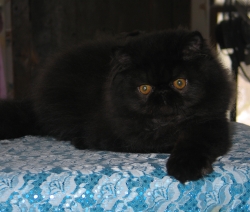 |
Blue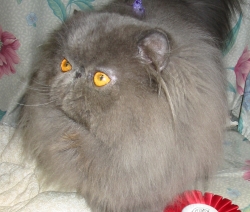 |
Red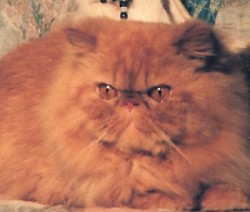 |
Cream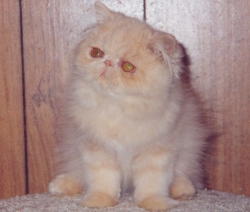 |
Tabby Division:
|
Brown Tabby |
Blue Tabby |
Red Tabby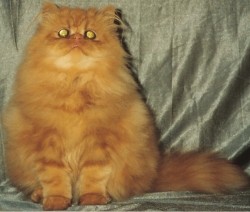 |
Cream Tabby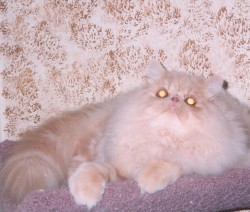 |
Brown Patched Tabby |
Blue Patched Tabby
|
Particolor:
Tortoiseshell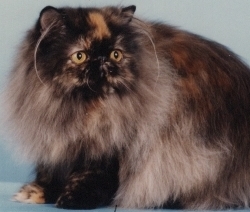 |
All Particolors & any cat
that has the color combination of one color with red or cream, can only
be female. Only on rare occasion has there been male torties, calicos, etc. Often times males in these colors are sterile. |
Blue-cream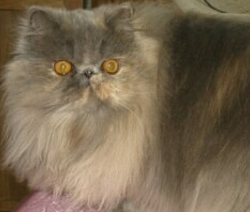 |
Bicolor:
Black & White |
Blue & White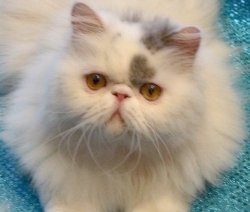 |
Red & White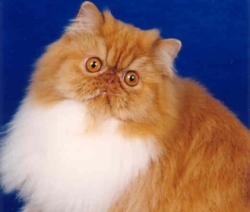 |
Cream & White |
Calico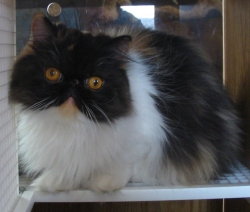 |
Dilute Calico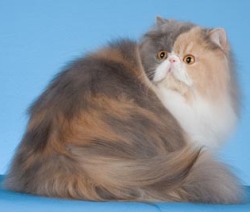 |
Red
Tabby & White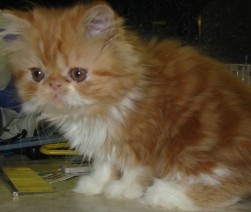 |
We also produce what is known
as the 'van pattern' in Bicolors. A van is only allowed to have 1 or 2 small body spots of color, and the rest of the cat is white. Vans are allowed color on their head, legs, and tail - which does not account towards the body color. |
Himalayan:
Seal Point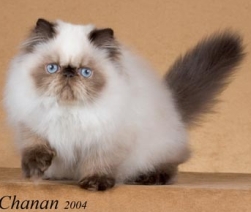 |
Blue Point |
Seal Lynx Point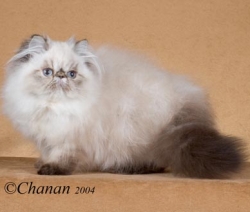 |
Blue
Lynx Point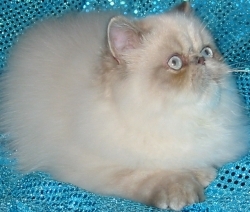 |
Flame Point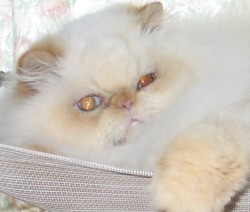 |
Cream Point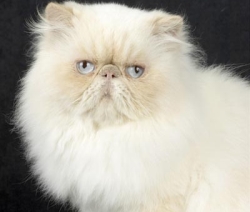 |
| Flame
Lynx Point No photo available at this time!
|
Cream
Lynx Point No photo available at this time!
|
Tortie
Point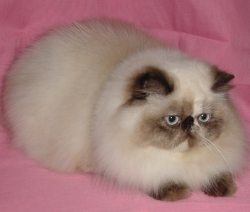 |
Blue-cream Point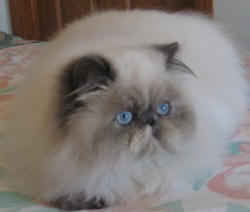 |
Tortie Lynx Point |
Blue-cream Lynx Point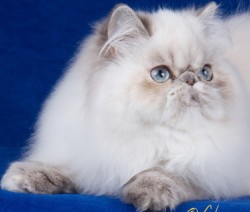 |
~***~
The Persian breed has 2
tabby patterns, Mackerel and Classic.
With the Classic pattern, you will see a 'bulls-eye' on each side of the body,
with
'butterfly wings' over the shoulders. The Classic Tabby pattern is recessive.
With the Mackerel Tabby pattern you will see thin pencil stripes going
vertically on the
sides of the body. The Mackerel Tabby pattern is a dominant gene.
Below is an example of each pattern:
Classic Tabby Pattern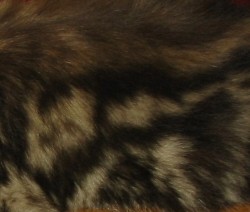 |
Mackerel
Tabby Pattern |
~***~
Cat Shows
Cat shows....yes, they do
exist!
No, we don't prance the cats around on a leash like at dog shows. ;o)
Instead, there is a section called the 'benching area', where exhibitors set
up there
cages for the cats to stay each day, along with their grooming supplies,
etc. There is usually
6-8 judging rings set up nearby. Each cat is judged in each ring, so
throughout the day, 12-15 cats
or so get called up at a time to be judged in their appropriate breed. After
judging is completed for each class
(Kittens, Championship, & Premiership), then the judge will call cats back
to their 'final'. This is the most exciting part!
About the classes of judging:
Kittens
- for kittens between the ages of 4 months - 8 months
Championship
- for whole cats age 8 months and up
Premiership
- for altered cats age 8 months and up
HHP (Household Pet)
- for altered cats/kittens of non-pedigreed lineage
Veterans
- for any pedigreed cat 7 years and older
And then there is the Agility ring. Cats here compete like in dog agility.
It's very entertaining to watch!
The Feline Agility is not at every show, but it is picking up fast, as this
is a fairly new addition to cat shows.
You can read more about it here:
http://agility.cfa.org
Whether you are just a cat lover, are interested in learning more about the
many breeds of cats, or if you are
considering starting your own cattery to breed & show cats, then visiting cat
shows is for you!
While visiting a show, there are also many great vendors to check out too!
You can usually find grooming/bathing supplies,
cat scratchers, toys galore, food/treats, clothing, jewelry, and so much
more!
Here are some more helpful links pertaining to cat shows:
CFA Show Schedule
(find a show near your area!)
http://www.cfa.org/exhibitors/show-schedule.html
First time
attending a cat show? Here is CFA's Spectator Tips:
http://www.cfa.org/shows/spectator-tips.html
Well, that's it for
now! We hope you find this informative & useful.
If you have any questions, feel free to email us!
Maybe we'll see you at a show soon!
Thanks!
This page written & compiled
by Tammy Swan, please do not copy in any way without written permission &
credit.
Some professional photos © Copyright Chanan Photography & all others by
Tammy-Dawn Swan/Ahmischi.
© Copyright 2001-2015 Ahmischi Cattery